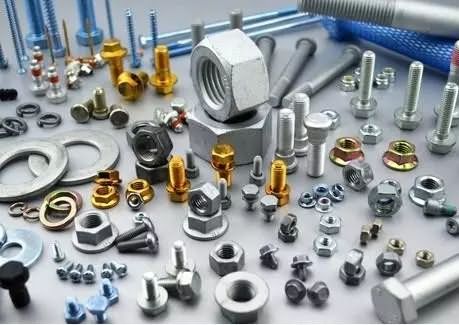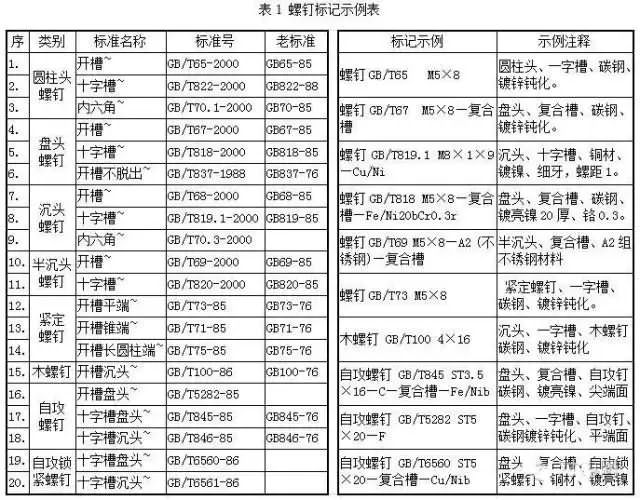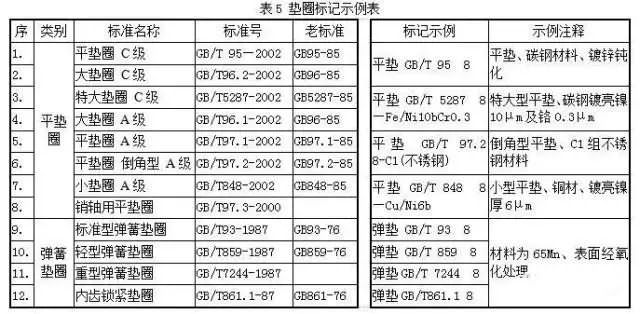1. Marking of screws or bolts: name, standard number, nominal diameter × pitch × nominal length - material - wrench form - surface treatment

a) Name: Use the standard name specified by the national standard, such as: screws, bolts, nuts, self-tapping screws, screw assemblies, plastic screws, etc.
b) Standard number: mark the country label, part label or enterprise label (do not write the year number). If it is designed by our company, mark the product model.
c) Pitch: only for fine thread, coarse teeth are omitted.
d) Material: If carbon steel material is used, this part is omitted, otherwise it should be injected, such as Cu (copper), C1 (stainless steel. The code of stainless steel material is detailed in GB3098.6, where: austenite, A1, A2 A4; martensite, C1, C3, C4; ferrite, F1.)
e) Twisting form: If the type of screwing specified by the standard is adopted, it shall be omitted, otherwise it shall be injected, such as a composite groove.
f) Surface treatment: if the carbon steel material is galvanized passivated, it is omitted, otherwise it should be injected, such as Cu/Ni (copper nickel plating), Cu/Ni6b (copper plating bright nickel, nickel layer thickness 6μm), Cu/Sn (copper tin plating), Cu/Sn (60) Pb (copper plated lead tin), Fe/Ni6bCr0.3r (carbon steel nickel plated chromium), O (surface oxidation), stainless steel materials usually do not need to be plated. If the coating complies with the ROHS directive, it is marked after surface treatment and placed in parentheses.

Note 1: If the material and surface treatment are not indicated in the marking of the fastener, the material of the fastener is carbon steel galvanized passivation (ie, zinc plating).
Note 2: There are two types of self-tapping screws, C and F, C is the tip end, and F is the flat end. However, the self-tapping locking screws are not classified.
Note 3: The difference between the pan head and the head is that the head of the pan head is slightly larger than the head of the cylinder, but the thickness of the head is slightly thinner than the head of the cylinder.
Note 4: The difference between the countersunk head and the semi-recessed head is that the head of the countersunk head is a flat end face, the head of the semi-recessed head is a curved end face, and the head of the countersunk head is thinner than the semi-recessed head.
Note 5: The difference between a set screw and a normal screw is that the shape of the head of the ordinary screw is T-shaped, and the set screw has no T-shaped head.
Note 6: Slotting means that the head is a slot. Composite tanks, cross recesses and slotted ones are common, but the same batch of products should be uniform.
Note 7: For stainless steel fasteners, in view of the unfamiliarity of our company's code, the “stainless steel” can be noted in the brackets after the material code.

Note 8: Difference between screw and bolt
Screw: It consists of two parts, head and screw. It is used in prefabricated thread and does not need to be used with nut. Commonly used inside the wrench, the head often has a hole.
Bolt: It consists of two parts, the head and the screw. It needs to be used with the nut to fasten the parts connecting the two through holes. The outer wrench is often a hexagonal head.

Note 9: If the screw assembly conforming to the XXXX enterprise standard is selected, the markings are: screw assembly ZBY1 (two combinations of screw and flat pad), ZBYA1 (three combinations of screw and flat pad, round spring pad), ZBF1 (screw) And the combination of the square flat pad), ZBFA1 (the combination of the screw and the square pad, the square spring pad).
2, the mark of the nut: name, standard number, nominal diameter × pitch - material - surface treatment
a) Name: Use the name of the standard specified by the national standard, such as: nut.
b) The identification of the standard number, pitch, material and surface treatment is the same as that of the screw.

3, the marking of the gasket: name, standard number, nominal diameter × pitch - material - surface treatment
a) Name: The standard name of the flat washer and spring washer is “washer”. However, in view of the actual situation of our company, in order to avoid confusion, the flat washer is named as “flat pad” and the spring washer is named as “bomb”. pad".
b) Nominal specification: refers to the large diameter of the thread, such as the large diameter of the external thread M8 is 8.
c) The identification of the standard number, material and surface treatment is the same as that of the screw.
d) If the material and surface treatment are not indicated in the mark of the elastic pad, the material is 65Mn, and the surface treatment is surface oxidation.

4, the mark of the retaining ring: name, standard number, nominal specification
a) Name: Uniformly named "Retaining Ring". Nominal specifications: refers to the shaft diameter or the bore diameter. The identification of the standard number is the same as that of the screw.
b) The material of the retaining ring is 65Mn, and the surface treatment is surface oxidation.

Note 10: In addition, the cylindrical pin is a commonly used fastener when manufacturing molds. The standard number is GB/T119-86. The marking example is: GB/T119 A 6×40 (representing the nominal diameter – the diameter of the big end is Φ6, nominal length is 40, the material is carbon steel, surface oxidation treatment, A shape.)
Note 11: When selecting fasteners, you should first select from the existing order numbers in the BOM list, and try to select fasteners that are commonly used or have a large inventory. New selection is allowed when it is confirmed that all pieces in the existing BOM database are not applicable.
Note 12: In the BOM system, all “×” numbers in the fastener mark are indicated by “*”.
Note 13: When the fastener marking format specified in this rule cannot express all its elements, it is allowed to add a suffix to the end of this naming format, and put it in parentheses, such as (XX exclusive), (natural), and so on.